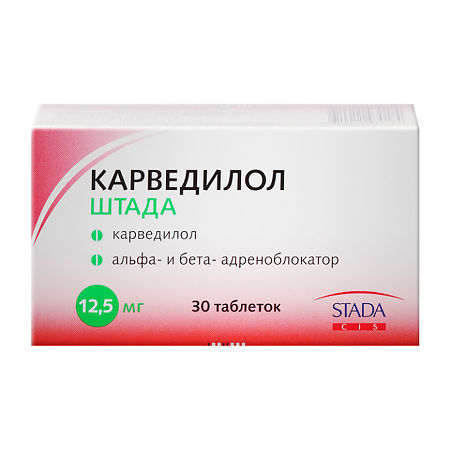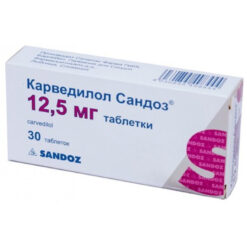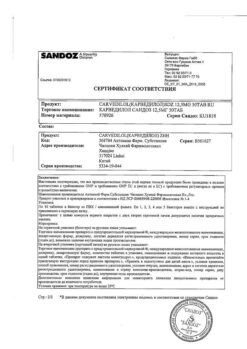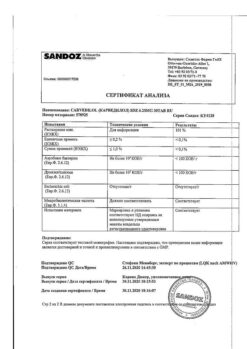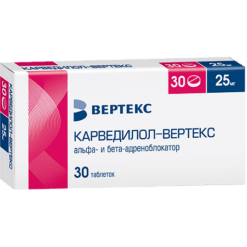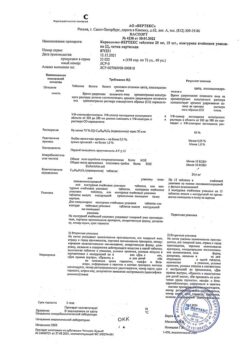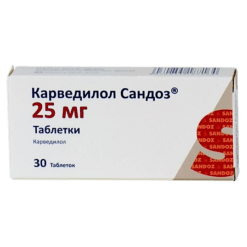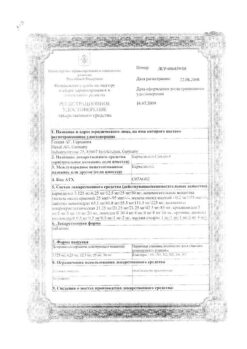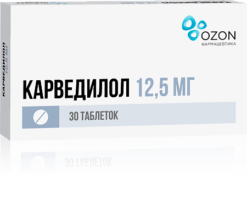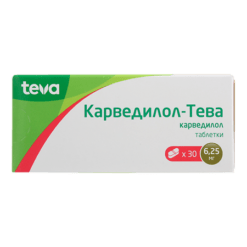No products in the cart.
Carvedilol, tablets 12.5mg, 30 pcs.
€1.00
Out of stock
(E-mail when Stock is available)
Description
Carvedilol blocks alpha1-, beta1- and beta2-adrenoreceptors.
It has vasodilatory, antianginal and antiarrhythmic effect.
It is a powerful antioxidant that eliminates free oxygen radicals.
It has antiproliferative effect against smooth muscle cells of vascular walls.
It has no sympathomimetic activity of its own and has membrane stabilizing properties.
Due to the blockade of cardiac beta-adrenoreceptors it reduces blood pressure (BP), cardiac output and decreases heart rate (HR) while maintaining myocardial contractility.
Suppresses the renin-angiotensin-aldosterone system through blockade of renal beta-adrenoreceptors, causing decreased plasma renin activity.
Selectively blocking alpha1-adrenoceptors causes dilation of peripheral vessels and reduction of total peripheral vascular resistance (TPR).
The combination of beta-adrenoreceptor blockade and vasodilation has the following effects: in patients with arterial hypertension – reduction of blood pressure;
in patients with coronary heart disease – anti-ischemic and antianginal action;
in patients with left ventricular dysfunction and circulatory insufficiency – favorable effect on hemodynamic parameters, increasing the ejection fraction and reducing the degree of left ventricular dilatation.
It has no pronounced effect on the lipid profile, the content of potassium, sodium and magnesium in the blood plasma.
Pharmacokinetics
After oral administration carvedilol is quickly and almost completely absorbed from the gastrointestinal tract.
It has high lipophilicity. It is 95-99% bound to blood plasma proteins. Concentration in blood plasma is proportional to the dose taken. Maximal concentration in plasma is reached after 1-1.5 hours.
Bioavailability of the preparation is 24-28%, in patients with liver function disorders it can increase up to 80%. Food slows down absorption of the drug, but does not affect bioavailability.
Metabolized in the liver to form a number of active metabolites with strong antioxidant and adrenoblocking effect.
60-75% of the absorbed drug is metabolized during the first “passage” through the liver.
It is eliminated mainly with the bile and feces. A small part of the dose is excreted through the kidneys as various metabolites. The elimination half-life is 6-10 hours.
With impaired renal function pharmacokinetic parameters of carvedilol do not change significantly.
Carvedilol penetrates through the placental barrier, is excreted with breast milk.
Indications
Indications
Active ingredient
Active ingredient
Composition
Composition
How to take, the dosage
How to take, the dosage
Interaction
Interaction
Catecholamine depleting agents (reserpine, MAO inhibitors) may cause severe bradycardia and arterial hypotension.
The concomitant administration of ACE inhibitors, thiazide diuretics, and vasodilators with carvedilol may lead to a dramatic drop in BP.
It enhances the effects of insulin and sulfonylurea derivatives (while masking or attenuating the severity of symptoms of hypoglycemia, reducing the breakdown of liver glycogen to glucose).
When concomitantly administered with insulin or oral hypoglycemic agents, blood glucose levels should be monitored.
The CYP2D6 isoenzyme inhibitors (quinidine, fluoxetine, propafenone) may increase the concentration of R(+)-enantiomer of Carvedilol.
The co-administration with antiarrhythmic drugs (especially class I) and BMCCs (verapamil, diltiazem) may provoke severe arterial hypotension and heart failure.
Intravenous administration of these drugs together with administration of Carvedilol is contraindicated.
The concentration of digoxin increases, which requires monitoring of digoxin concentrations because concomitant administration with cardiac glycosides can lead to AV blockade.
General anesthetics increase negative inotropic and hypotensive effects. Phenobarbital and rifampicin accelerate metabolism and decrease plasma concentration of Carvedilol.
Microsomal oxidation inhibitors (cimetidine), diuretics and ACE inhibitors increase the concentration and enhance the hypotensive effect of carvedilol. Carvedilol delays the metabolism of cyclosporine.
Special Instructions
Special Instructions
Contraindications
Contraindications
Side effects
Side effects
In the recommended doses, Carvedilol is well tolerated, but in some cases, side effects may occur.
Digestive system disorders: nausea, dry mouth, abdominal pain, diarrhea or constipation, vomiting, increased liver transaminase activity.
Nervous system disorders: headache, dizziness, fatigue, loss of consciousness, muscle weakness (usually at the beginning of treatment), sleep disorders, depression, paresthesias.
Sensory organs: decrease in lacrimation.
Urinary system disorders: renal dysfunction, edema, urinary disorders.
Hematopoietic disorders: leukopenia, thrombocytopenia.
Allergic reactions: urticaria, itching, rash, appearance and/or exacerbation of psoriasis, sneezing, nasal congestion, bronchospasm, shortness of breath (in predisposed patients), very rare – anaphylactoid reaction.
Systemic diseases: bradycardia, orthostatic hypotension, angina pectoris, AV blockade, progression of circulatory failure (cold extremities), progression of heart failure, worsening of intermittent claudication and Raynaud’s syndrome.
Endocrine disorders: weight gain.
Others: pain in extremities, flu-like symptoms.
As with other drugs that block alpha-adrenoreceptors, latent diabetes mellitus may appear or increase its symptoms.
Overdose
Overdose
Symptoms:
A marked decrease in BP (BP 80 mmHg or lower), marked bradycardia (less than 50 bpm), impaired respiratory function (bronchospasm, etc.), chronic circulatory failure, cardiogenic shock, cardiac arrest.
Treatment:
In the first two hours, induce vomiting and flush the stomach.
An overdose requires intensive treatment, vital functions must be monitored.
The patient should be in an elevated leg position, i.e., Trendelenburg position.
The beta-blocking antidotes are orciprenaline or isoprenaline 0.5-1 mg IV and/or glucagon at a dose of 1-5 mg (maximum dose 10 mg).
Severe hypotension is treated with parenteral fluid administration and repeated administration of adrenaline at a dose of 5-10 mg (or its intravenous infusion at a rate of 5 µg/min).
In case of excessive bradycardia, administer IV atropine at a dose of 0.5-2 mg. To maintain cardiac activity: glucagon is administered rapidly (within 30 seconds) by IV, followed by a continuous infusion at a rate of 2-5 mg/h.
If peripheral vasodilator action prevails (warm limbs, in addition to significant arterial hypotension), norepinephrine should be administered at 5-10 mcg as an IV infusion of 5 mcg/min.
To relieve bronchospasm, beta-adrenomimetics (as an aerosol or intravenously) or aminophylline intravenously are prescribed.
If seizures develop, slow administration of diazepam or clonazepam is recommended.
In severe cases of intoxication when symptoms of shock predominate, treatment should continue until the patient is stabilized, taking into account the T1/2 of carvedilol, which is 6-10 h.
Similarities
Similarities
Additional information
| Shelf life | 3 years. Do not use after the expiration date on the package. |
|---|---|
| Conditions of storage | In a dry, light-protected place at a temperature not exceeding 25 ºС. Keep out of reach of children. |
| Manufacturer | Chemopharm LLC, Russia |
| Medication form | pills |
| Brand | Chemopharm LLC |
Other forms…
Related products
Buy Carvedilol, tablets 12.5mg, 30 pcs. with delivery to USA, UK, Europe and over 120 other countries.

